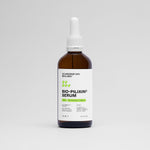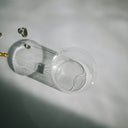Many people experience changes in their hair density and thickness over time. If you've noticed that your hair is so thin that you can see your scalp, you're not alone. This condition can be frustrating and may lead to concerns about hair health and appearance. Understanding the reasons behind thin hair and exploring potential solutions can help you regain confidence and promote healthier hair.
Table of content
My hair is so thin I can see my scalp - what does it mean?
If your hair is so thin that you can see your scalp, it typically indicates a lack of hair density or volume. This can be caused by several factors, including genetics, hormonal changes, nutritional deficiencies, stress, and certain medical conditions. Seeing your scalp through your hair may also suggest that your hair follicles are not producing as much hair as they should be, leading to a more visible scalp. However, this condition can often be addressed with the right approach.
There are several common reasons for experiencing thin hair:
- Genetics: Family history plays a significant role in hair thickness. If your parents or grandparents had thin hair, you might be genetically predisposed to the same condition.
- Hormonal Changes: Hormonal fluctuations, especially during pregnancy, menopause, or due to conditions like polycystic ovary syndrome (PCOS), can contribute to thinning hair.
- Nutritional Deficiencies: Lack of essential nutrients such as protein, iron, vitamins D and B12, and omega-3 fatty acids can affect hair health and lead to thinning.
- Stress: High-stress levels can result in a type of hair loss called telogen effluvium, where hair follicles enter a resting phase and result in increased shedding.
- Medical Conditions: Certain medical issues like thyroid disorders, autoimmune diseases, and scalp conditions can also lead to thinning hair.
Once you understand the potential causes, it’s essential to explore treatment options to combat thinning hair and improve overall hair health.
As your leading source for hair health information over the past 4 years, we never compromise on accuracy. When it comes to your health, you deserve information you can truly rely on - and earning your trust is our top priority.
Here's how Scandinavian Biolabs ensures every piece of content meets the highest standards of accuracy and integrity:
- Credentialed Experts: Our reviewers are actively practicing doctors and medical researchers
- Stringent Reviews: Content undergoes rigorous editing by subject specialists and review by a practicing doctor.
- Evidence-Based: We rely on well-established research from trusted scientific sources like peer-reviewed journals and health authorities.
- Full Transparency: Our editorial standards, writer credentials, reviewer credentials, correction process, and funding are all publicly documented.
- Independent Voice: While we do promote products, we operate in a vacuum to business operations. Our main goal is just an unwavering commitment to providing medically-sound guidance.
You can count on Scandinavian Biolabs to consistently deliver the trustworthy health information you deserve. Read our Editorial Standards.
What can I do if my hair is thin and I can see my scalp?
Addressing thin hair requires a multi-faceted approach that includes lifestyle changes, potential treatments, and professional advice. Here are several strategies to consider:
- Consult a Dermatologist: If you're concerned about your thinning hair, it's advisable to consult a dermatologist. They can evaluate your scalp and hair condition, recommend appropriate treatments, and rule out any underlying medical issues.
- Improve Your Diet: Eating a balanced diet rich in vitamins and minerals can promote hair health. Focus on incorporating foods high in protein, iron, biotin, and omega-3 fatty acids. Foods such as eggs, nuts, leafy greens, fish, and lean meats can be beneficial.
- Consider Supplements: If you suspect nutritional deficiencies, consider taking hair growth supplements after consulting with a healthcare provider. Biotin, vitamin D, and iron supplements can promote healthier hair growth.
- Reduce Stress: Managing stress through activities like yoga, meditation, or regular exercise can help reduce the impact of stress on your hair. Incorporating relaxation techniques into your routine can also aid in overall well-being.
- Use Gentle Hair Care Products: Opt for sulfate-free shampoos and conditioners that are gentle on the scalp and hair. Avoiding harsh chemicals and heat styling tools can help prevent further damage and breakage.
- Explore Topical Treatments: Over-the-counter treatments like minoxidil (Rogaine) can promote hair regrowth for some individuals. It’s best to consult with a dermatologist before starting any new treatment.
- Hairstyles and Haircuts: Choosing the right hairstyle can create the illusion of thicker hair. Layered cuts, bobs, and avoiding heavy products can help manage the appearance of thinning hair.
When should I seek professional help for thinning hair?
If you notice rapid hair loss, patches of baldness, or significant changes in your hair’s texture, it’s essential to seek professional help. A dermatologist can conduct tests to determine the underlying cause of your hair thinning and recommend a suitable treatment plan tailored to your needs.
Conclusion
Seeing your scalp through thin hair can be concerning, but there are effective strategies to address this issue. By understanding the potential causes and implementing lifestyle changes, dietary improvements, and seeking professional advice, you can promote healthier hair growth. Remember, patience is key, as hair growth takes time. If you're proactive and focused on your hair health, you can work towards achieving thicker, fuller hair.
```Tired of Thinning Hair? Try a Clinically Tested Serum.
Looking for a natural way to regrow hair and achieve a thicker, fuller head of hair? Ditch the stinging nettle for hair loss – Bio-Pilixin Serum is a drug-free hair activation serum that delivers clinically tested results.
Here's why Bio-Pilixin is superior:
- Clinically Tested Results: 93% of users saw a reduction in hair loss, and 73% experienced increased hair density.
- Safe and Natural: Unlike harsh chemicals, Bio-Pilixin uses plant growth factors derived from stem cell technology to nourish hair follicles and stimulate growth.
- Fast-Acting: See visible results in as little as 45 days (most typically see results within 150 days).
Stop wasting time on unproven remedies. Bio-Pilixin is the safe, natural serum you've been searching for.
Read more:






